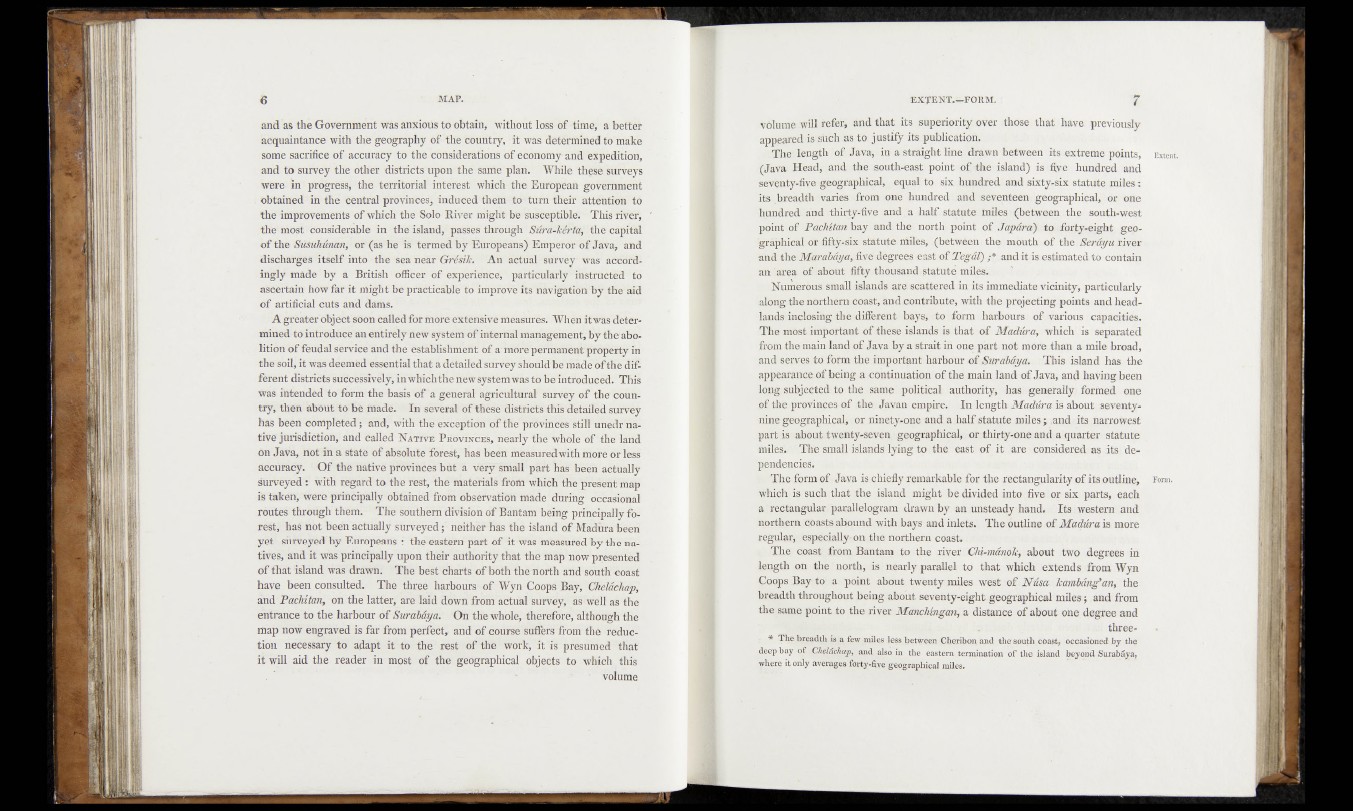
and as the Government was anxious to obtain, without loss of time, a better
acquaintance with the geography of the country, it was determined to make
some sacrifice of accuracy to the considerations of economy- and expedition,
and to survey the other districts upon the same plan. While thgse surveys
were m progress, the territorial interest which the European government
obtained in the central provinces, induced them to turn their attention to
the improvements of which the Solo River might be susceptible. This river,
the most considerable in the island, passes through Stira-kerta, the capital
of the iSusuhunan, or (as he is termed by Europeans) Emperor of Java, and
discharges itself into the sea near Gresik. An actual survey' was accordingly
made by a British officer of exprerience, particularly instructed to
ascertain how far it might be practicable to improve'its navigation by the aid
of artificial cuts and dams.
A greater object soon called for more extensive measures. When it was determined
to introduce an entirely new system of internal management, by the1 abolition
of feudal service and the establishment of a more'perihanent property in
the soil, it was deemed essential that a detailed survey should be made ortfib difl
ferent districts successively, in which the newsystcm was to be introduced. This
was intended to form the basis of a general agricultural1 survey of the'country,
then about to be made. Sh several of these districts this detailed sur'vey
has been completed; and, with the exceptidii of the pfSvincfeis stiH uti'^rina-
tive jurisdiction, and called N ative P rovinces, nearly the whole Of the land
On Java, not in a state of absolute forest, has been-measured with more dr less
accuracy. Of the native provinces but a very"small part has been actually
surveyed: with regard to the rest, the materials from which the'preseUt map
is takeni #dre principally obtained from observation made during occasional
routes through them; THe sduthem division of Bantam being principally forest,
has not been actually surveyedneither has the island of Madura been
yet surveyed1 by Europeans : the eastern part of it was measured by the natives,
and it was principally upon their authority that the map now presented
of that Island was drawn. The best charts of both the north and south’doa'sf
have been consulted. The three harbours-of Wyn Coops Bay, ChelacJiap,
and Pachitan, on the latter, are laid down from actual survey, as1 well as the
entrance to the harbour o f Surabaya. On tfa'e whole,-therefore, although the
map now engraved is far from perfect, and of course suffers from the reduction
necessary to adapt it to the rest of the work, it is presumed that
it will aid the reader in most of the geographical objects to which this
. 5 ~ * . volume
Volume will refer, and that its superiority over .those that have previously
a p p e a r e d is,siieh .as to: justify its publication.
The length of Java, in a straight line drawn between its extreme points, Extent.
(Java Head, and the. »south-east point of-the island) is five hundred and
seventy-five- geographical, equal to. six hundred and sixty-six statute miles:
its ,breadth varies from one hundred and .seventeen, .geographical, or one
hundred and thirty-five and,a half statute Iniles (between-the south-west
point dfbPacMtan bay and the- northi point of Japdrai) to forty-eight geographical
of fifty-six statute,miles, .(between, the mouth, of the.Serfiyu river
and the Marabdya, five degrees east of Tegal) ;* and it is estimated to contain
an area of »about fifty .thousand.statute miles.i ..
»Numerous, small -islands are scattered in its immediate vicinity, particularly
■along the northern coast, and contribute, with the projecting points and head-
lan^?Sbfl^®ii®jifc:di&rent bays, to form harbours , of various capacities.
The most important of-.these islands is that of Madura, which is separated
from the main land, of Java by a strait in one part not more..than a mile broad,
and serves to form the. important harbour of Surabaya. This island has the
appearance of being ».continuation of the,main land of Java, and having been
long-subjected to the same political authority, has generally formed one
,©£:%e provinces of .the Javan empire. In length Madura is about seventy-
nine geographical, or ninety-one and a half statute miles j /and its narrowest
part is aboutitwentyp-severy-geographical, or thirty-one and a quarter statute
mil'esU The small islands' lying to the east of it are considered as itsfdfe- -
pendencies., r
. The form of. Java is chiefly remarkable for the rectangularity q/f its outline, Few-
‘Which 'is such that th.e island might be.divided into five or six parts, each
a rectangular parallelogram drawn by an unsteady hand, Its.western and
northern cSOasts abound with bays and inlets. The outline o£ Madura is more
regular, especially-on.the northern coast. .1
The coast1, from Bantam to the river Chi-mdnpk, about two degrees in
length on the north, is nearly parallel to that which extends from, Wyn
Coops Bay-to~ a point about twenty miles west -of: Nusa, kambdng’an, the
breadth throughout .being about seventy-eight geographical miles; and from
thersame point to the river Manchingan, a distance of about one degree and
. _ .... three-
■ * The breadth is £ few [miles less between Cheribonand the south coast, occasioned by the
deep bay Chelackwp, and also in the eastern,.termination of the island beyond Surabaya,
where it omy averages forty-five geographical miW